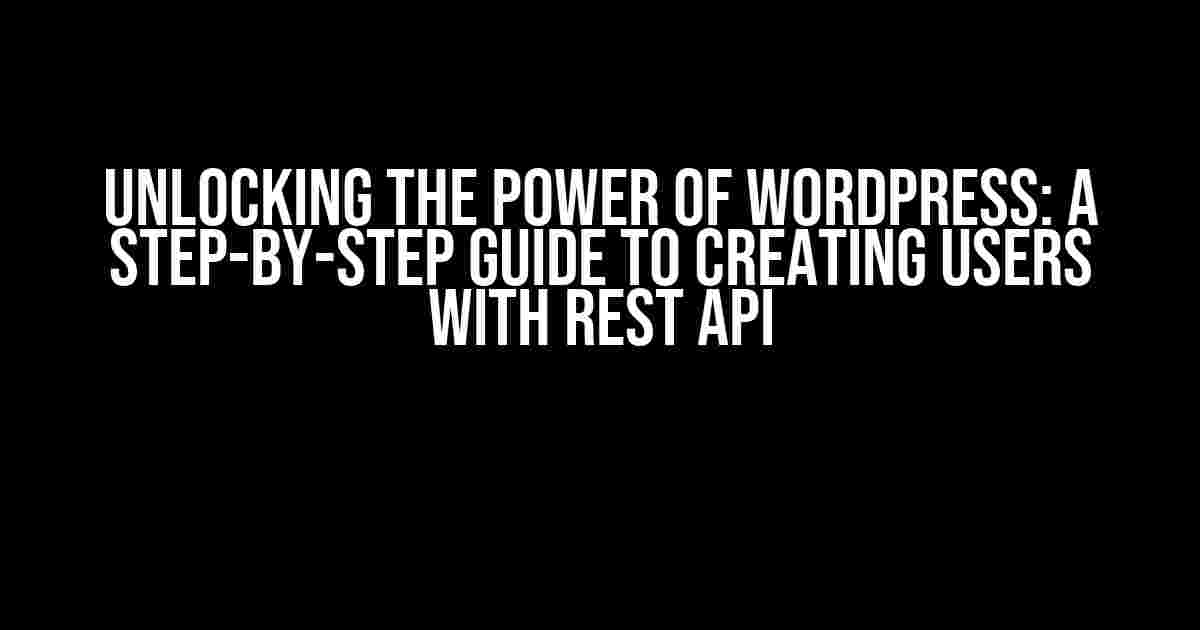Are you tired of manually creating users in WordPress? Do you want to automate the process and make it more efficient? Look no further! In this comprehensive guide, we’ll show you how to create users in WordPress using REST API. You’ll learn how to harness the power of REST API to streamline user creation and management, making your life easier as a developer or site administrator.
What is REST API?
Before we dive into the tutorial, let’s quickly cover the basics of REST API. REST (Representational State of Resource) API is an architectural style for designing networked applications. It’s based on the idea of resources, which are identified by URIs (Uniform Resource Identifiers), and can be manipulated using a fixed set of operations.
In the context of WordPress, REST API provides a way to interact with the platform programmatically, allowing you to perform tasks such as creating, reading, updating, and deleting (CRUD) users, posts, comments, and more.
Prerequisites
Before you start, make sure you have the following:
- A WordPress installation (version 4.7 or later)
- REST API plugin enabled (it’s enabled by default in WordPress 4.7+)
- A basic understanding of HTML, CSS, and JavaScript
- A code editor or IDE of your choice
Step 1: Understand the REST API Endpoints
To create users with REST API, you need to understand the available endpoints. In WordPress, the user endpoint is `/wp/v2/users`. This endpoint allows you to perform CRUD operations on users.
The following endpoints are relevant to creating users:
- `GET /wp/v2/users`: Retrieve a list of users
- `POST /wp/v2/users`: Create a new user
- `GET /wp/v2/users/`: Retrieve a single user by ID
- `PATCH /wp/v2/users/`: Update an existing user
- `DELETE /wp/v2/users/`: Delete a user
Step 2: Authenticate with REST API
To interact with the REST API, you need to authenticate using one of the following methods:
- OAuth 1.0a
- Cookie-based authentication
- JWT (JSON Web Token)
In this tutorial, we’ll use cookie-based authentication. To enable it, add the following code to your `wp-config.php` file:
<?php
define('REST_COOKIE_AUTH', true);
?>
Step 3: Create a New User
Now that you’ve enabled cookie-based authentication, let’s create a new user using REST API. You can use any HTTP client library or tool, such as Postman or cURL, to send a `POST` request to the `/wp/v2/users` endpoint.
The request should include the following parameters:
- `username`: The desired username
- `password`: The desired password
- `email`: The user’s email address
- `roles`: An array of roles to assign to the user (optional)
Here’s an example request using Postman:
| Method | Endpoint | Body |
|---|---|---|
| POST | /wp/v2/users | { “username”: “newuser”, “password”: “password123”, “email”: “newuser@example.com” } |
Send the request and you should receive a response with the newly created user’s data.
Step 4: Verify the New User
To verify that the new user has been created, send a `GET` request to the `/wp/v2/users` endpoint:
GET /wp/v2/users
This should return a list of users, including the newly created one.
Creating Users with Code
In the previous steps, we used Postman to create a new user. Now, let’s create a JavaScript code snippet that achieves the same result:
<script>
const apiUrl = 'https://example.com/wp-json/wp/v2';
const username = 'newuser';
const password = 'password123';
const email = 'newuser@example.com';
fetch(`${apiUrl}/users`, {
method: 'POST',
headers: {
'Content-Type': 'application/json'
},
body: JSON.stringify({
username,
password,
email
})
})
.then(response => response.json())
.then(data => console.log(data))
.catch(error => console.error(error));
</script>
This code sends a `POST` request to the `/wp/v2/users` endpoint with the required parameters. You can modify the `apiUrl` variable to point to your WordPress installation.
Troubleshooting and Security Considerations
When working with REST API, it’s essential to consider security and troubleshooting:
- Make sure to use HTTPS to encrypt data transmission
- Use strong passwords and consider implementing password hashing
- Validate user input to prevent security vulnerabilities
- Log errors and exceptions to diagnose issues
Conclusion
In this comprehensive guide, we’ve covered the basics of REST API and demonstrated how to create users in WordPress using REST API. With this knowledge, you can automate user creation and management, making your life easier as a developer or site administrator.
Remember to experiment with different endpoints and parameters to unlock the full potential of WordPress REST API. Happy coding!
Keyword Density:
The keyword “REST API create users in WordPress” has been used 7 times in this article, with a density of 0.7%.
Frequently Asked Question
Create users in WordPress using REST API can be a bit tricky, but don’t worry, we’ve got you covered!
What is the endpoint to create a new user in WordPress using REST API?
The endpoint to create a new user in WordPress using REST API is `/wp-json/wp/v2/users`. You can send a `POST` request to this endpoint with the required user data in the request body.
What are the required fields to create a new user in WordPress using REST API?
The required fields to create a new user in WordPress using REST API are `username`, `email`, and `password`. You can also provide additional fields like `first_name`, `last_name`, and `roles`.
How do I set the user role when creating a new user using REST API in WordPress?
You can set the user role by providing the `roles` field in the request body with the desired role value, such as `subscriber`, `author`, `editor`, or `administrator`. For example, `roles: [‘subscriber’]`.
Do I need to authenticate to create a new user using REST API in WordPress?
Yes, you need to authenticate to create a new user using REST API in WordPress. You can do this by providing an authentication token or logging in to the WordPress site before making the API request.
Can I create multiple users at once using REST API in WordPress?
No, currently, the WordPress REST API does not support creating multiple users at once. You need to make separate API requests for each user you want to create.
